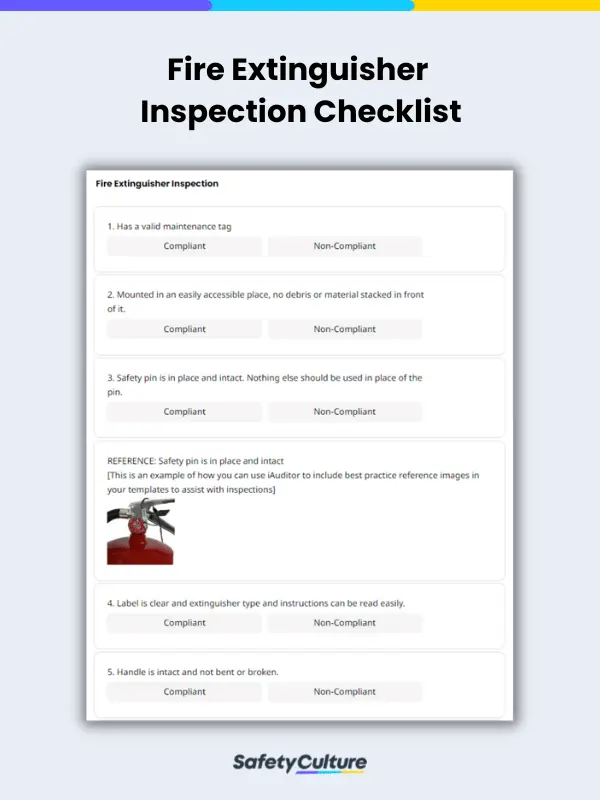What is a Fire Extinguisher Inspection Checklist?
A fire extinguisher inspection checklist is an essential tool for safety officers and facility managers, helping ensure that all fire extinguishers are maintained in optimal working condition during routine inspections. Fire extinguisher inspection checklists enable inspectors to record details about the fire extinguishers, such as labels, maintenance tags, exact location, and current condition.
Employers are required to provide fire extinguishers in the workplace and have it inspected every month. This lowers risks and prevents potential issues in the event that a fire extinguisher is needed. Follow all steps in the checklist for a thorough inspection and proper documentation.
Why Use a Fire Extinguisher Checklist?
These checklists enable inspectors to proactively identify any issues that could compromise the effectiveness of fire extinguishers during emergencies. Employers must adhere to legal requirements that mandate monthly visual inspections of portable fire extinguishers. Non-compliance with these regulations exposes businesses to penalties and may jeopardize the safety of employees and the workplace in the event of a fire incident.
To meet the obligations for annual or monthly fire extinguisher inspections, individuals can employ a fire extinguisher self-inspection checklist or a comprehensive fire self-inspection checklist that encompasses an evaluation of fire extinguishers. By utilizing these checklists, businesses and individuals can proactively contribute to a safer work environment and ensure compliance with fire safety regulations.
What to Check During Monthly Fire Extinguisher Inspections
The following parts are checked and tasks are completed during monthly fire extinguisher inspections. These are done not only for compliance with the law but also because annual inspections also require a consistent record of maintenance since these tools often need to be recharged/replaced. Here are the following items to check during a monthly fire extinguisher inspection:
- Make sure that the inspection tag is valid.
- Confirm that the fire extinguisher is mounted in an easily accessible place with no debris or material stacked in front of it.
- Ensure that the safety pin is intact and in place, and nothing else is used in place of the pin.
- Verify that the label, extinguisher type, and instructions are clear and easy to read.
- Check that the handle is intact, not bent or broken.
- Inspect the pressure gauge to ensure it is in the green zone and not damaged or indicating recharge.
- Examine the discharge hose/nozzle to ensure it is in good condition, not clogged, cracked, or broken.
- Confirm that it is full by turning it upside down at least three times. This also prevents the contents from compacting.
- Identify the location of the extinguisher by checking that signs clearly mark its position.
- Dust and wipe down the extinguisher to keep it clean.
- Indicate the overall condition of the extinguisher as either pass or fail.
- Once inspection is complete, sign and enter the date of the inspection in the annual maintenance tag.
These 12 steps are found in this fire extinguisher checklist format that can be downloaded for free.
What to Include in a Fire Extinguisher Inspection Checklist
Fire extinguisher inspection checklists help inspectors conduct and record their monthly and yearly checks with due diligence, preventing them from missing crucial points in checking if fire extinguishers are in good working condition. Here are what a checklist typically contains based on a monthly fire extinguisher inspection form:
Information about the fire extinguisher
Inspectors need to know and record the exact location of the extinguisher as well as the following—serial number, manufacture and expiry date, type, size, and rating of the fire extinguisher.
Details of the visual inspection
Does the extinguisher have a valid maintenance tag that is signed and dated? Is the extinguisher accessible and its safety pin is intact with the handle not bent or broken? Other information to note are—label should be clear, pressure gauge as at green, hoses in good condition, and if the extinguisher is full.
Confirmation of inspection
The inspector should sign and include the date on the fire extinguisher inspection checklist to confirm the completion of the inspection. Also, if applicable, sign the inspection tag of the fire extinguisher.
Fire Extinguisher Inspection Report PDF
Visit this page to learn more about how to conduct fire extinguisher inspections. We also prepared a PDF guide to show you what a completed monthly fire extinguisher inspection report should look like.

Fire Extinguisher Inspection Sample PDF Report
FAQs about Fire Extinguisher Inspection Checklists
What are the 4 steps in inspecting a fire extinguisher?
How often should fire extinguishers be inspected using a checklist?
What should I do if I find issues during an inspection?



